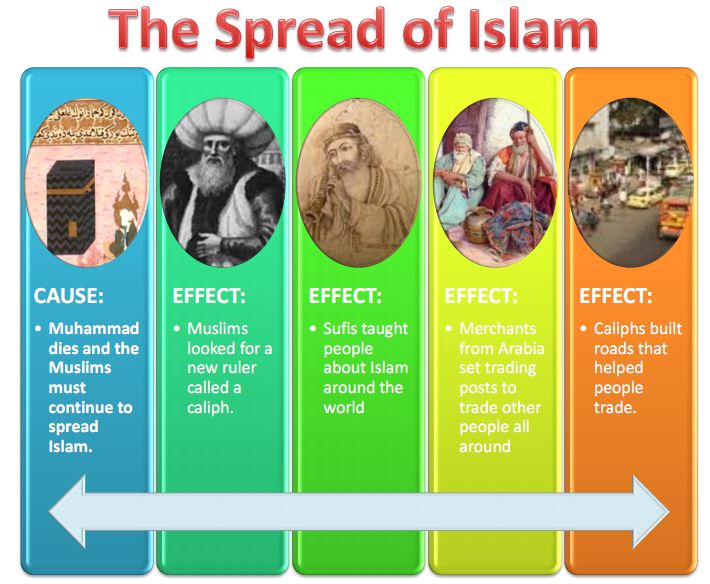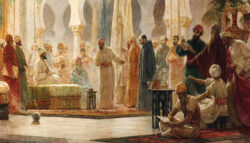Everyone one want to know about a history of Islam: How a Religion Began and Evolved?
 Introduction
Introduction
Islam is one of the most widely practiced religions in the world, with more than 1.8 billion adherents worldwide. But how did this religion begin and evolve? This blog post will explore the history of Islam, from its earliest beginnings to its current state today. We’ll look at the major events that took place in the development of Islam and how it has shaped the world we know today. We’ll also examine how the teachings of Muhammad have been interpreted and applied throughout the centuries, and the impact that this has had on the faith and its followers.
 The origins of Islam in the Arabian Peninsula
The origins of Islam in the Arabian Peninsula
The origins of Islam can be traced back to the Arabian Peninsula in the 7th century CE. At that time, Arabia was populated by polytheistic Arab tribes who practiced different religions and rituals. In this environment, a man by the name of Muhammad began to preach his new message of monotheism. He proclaimed that there was only one true God and that he was the messenger of God.
Muhammad’s teachings quickly spread throughout the Arabian Peninsula. He attracted followers from all corners of the region and gained the support of many influential figures. Soon, the people of Arabia began to convert to Islam and its principles of submission to the will of Allah and justice for all.
In time, the followers of Muhammad spread beyond the boundaries of Arabia. They eventually conquered much of the Middle East, North Africa, Central Asia, and parts of Europe. As their influence grew, so too did their faith. Over the centuries, Islamic practices and beliefs were refined and codified in the Quran and Hadith.
Today, Islam is one of the world’s largest and most influential religions, with over 1.6 billion adherents around the globe. While it has faced its share of challenges, such as those posed by extremism, it remains a vibrant and diverse faith that continues to shape our lives and our societies. The Muslim tradition holds that Prophet Muhammad received the first revelation of the Quran on Mount Hira near Mecca while meditating during Ramadan. Muslims believe these revelations are verses or signs which have been passed down through generations as direct divine guidance.
Islam emerged following tribal conflicts among early inhabitants in Mecca and Medina, where two major clans were competing for power.
Islam teaches Muslims how to establish righteous relations among themselves, within society, and between them and other nations (Muslims).
 The life of Muhammad and the early Caliphate
The life of Muhammad and the early Caliphate
Muhammad’s teachings eventually led to the formation of the Islamic community, known as the ummah. After his death in 632 CE, his followers established the first caliphate, or Islamic state, which quickly spread across the Middle East and into North Africa and beyond. The caliph was the political and spiritual leader of the Islamic world and was responsible for both upholding Islamic law and spreading its message throughout the region.
The early caliphate was divided into two major empires: the Umayyad and Abbasid caliphates. During this period, Islamic scholars developed a sophisticated body of knowledge based on both Islamic and Greek philosophy, which included astronomy, mathematics, medicine, and science. As a result, Muslims made great strides in many areas, including architecture and literature.
The Umayyad caliphate fell in 750 CE, marking the beginning of a period of fragmentation within the Islamic world. In 1258 CE, Baghdad, the Abbasid capital, fell to Mongol invaders and the caliphate was eventually abolished. Despite this setback, Muslims continued to practice their faith and develop their culture over the centuries. Today, Muslims make up one of the largest religious groups in the world, with over 1.5 billion adherents worldwide. Islamic communities exist in diverse geographic regions such as Indonesia, Malaysia, Northern Nigeria, Southern India, and Southern Europe. However, there are few countries where Muslims form the majority population. The Sunni branch of Islam is dominant in the Muslim world today. The most famous adherent is Osama bin Laden who called himself a holy warrior waging jihad against non-Muslims
 The spread of Islam throughout the world
The spread of Islam throughout the world
Islam is one of the world’s oldest and most widely practiced religions. It began in the 7th century CE in the Arabian Peninsula with the revelation of the Quran to the Prophet Muhammad. Since then, it has spread throughout the world and is now practiced by over 1.6 billion people.
The spread of Islam was largely due to the influence of Arab traders and conquerors. As they traveled and traded goods, they spread their faith as well. In a short period of time, much of the Middle East and North Africa adopted Islam. Later, during the period of Ottoman Empire expansion, Islam spread into parts of Central Asia and South Asia.
In addition to conquest, many converts embraced Islam willingly. They were attracted to its monotheistic teachings and its moral principles. Many of these converts lived in areas that had limited access to other religions and cultures. As Islam became more established in new lands, schools and universities were established, which allowed for further dissemination of Islamic beliefs.
Today, Islam is one of the most widely practiced religions in the world, with adherents living in every continent. While there are some countries where non-Muslims are persecuted or denied rights, most Muslim countries are very tolerant of non-Muslims, allowing them to practice their religion without interference. For example, in Qatar all faiths are free to worship at temples and churches.
Some Muslims believe that the majority of people should be Muslim; others believe that any person can choose what to believe so long as he does not interfere with another’s right to worship freely. A debate on this issue has been going on since Islam first came into being.
 The Golden Age of Islam
The Golden Age of Islam
The period known as the Golden Age of Islam began in the 8th century and lasted until the 13th century. It was a time of immense intellectual, scientific, and cultural progress in the Islamic world. It was during this period that many of the most important contributions to Islamic scholarship were made, such as advances in mathematics, science, literature, philosophy, and medicine.
The Islamic Golden Age is attributed to the expansive empire established by the Muslim Caliphates. During this time, Muslim rulers had a large degree of control over the Mediterranean world, and thus had the power to spread their culture and knowledge far and wide. This period also saw the expansion of trade and commerce, which facilitated a greater exchange of ideas and technologies between different regions.
During this period, many famous scholars and scientists such as Al-Khwarizmi, Ibn Sina, and Ibn Rushd made significant contributions to the Islamic world. These scholars revolutionized the fields of mathematics, medicine, philosophy, and astronomy. Their works were studied and copied by European scholars centuries later. As a result of these advancements, the Arabic numerals are now used worldwide. One scholar who stands out from among all others is Avicenna (980-1037), whose name means the philosopher in Arabic. He contributed greatly to Islamic philosophy, but he also wrote extensively on almost every branch of philosophical study including logic, metaphysics, psychology, and natural sciences. His major contribution came with his Kitab al-Shifa (The Book of Healing), one of the most influential books in history and an early example of existentialism.
 The decline of the Abbasid Caliphate
The decline of the Abbasid Caliphate
The Abbasid Caliphate, which lasted from 750 to 1258 CE, was the second of the four major Islamic caliphates. Under their rule, the Islamic world achieved unprecedented levels of political, economic, and cultural prosperity. The Abbasids were renowned for their art, architecture, literature, and science. However, after several centuries of stability and progress, the Abbasids began to decline in the tenth century due to a combination of factors.
External pressures from Christian Crusaders, Mongol invasions, and the subsequent weakening of the caliphate’s control over its provinces all played a role in its decline. Internal issues such as power struggles between family members and rival claimants to the throne also contributed to the decline. By 1258, the Abbasid caliphate had fallen completely, replaced by smaller independent dynasties throughout the Islamic world. A major consequence of the demise of this long-lasting dynasty is that much knowledge and scholarship produced during this time period is no longer available to us today. In addition, the rise of Shiite Muslims who did not recognize the authority of an absolute ruler (the Shiites followed Muhammad’s son-in-law Ali) would contribute to the fragmentation and eventual fall of Baghdad in 1258 when it was captured by Hulagu Khan, grandson of Genghis Khan.
 The Ottoman Empire and the Mughal Empire
The Ottoman Empire and the Mughal Empire
The Ottoman Empire was largely based on Sunni Islam and maintained a strict adherence to Sharia law. It was an autocratic state with an absolute ruler who wielded great power over his subjects. Its military forces were highly organized and capable of conquering much of the known world. Its capital city of Istanbul served as a major center for Islamic art, learning, and culture. The Mughal Empire was much more eclectic than the Ottoman Empire and was composed of various ethnic and religious groups. However, it too held strong religious values, with Islamic culture being a central part of its identity. Both empires were largely responsible for the spread of Islam throughout South Asia and helped to create a lasting legacy of Islamic culture in the region. As one empire conquered other territories, Muslim governors and officials would take control of them. Eventually, Islam became widespread through these regions because not only were there wars fought by Muslims against non-Muslims but also converts from among non-Muslims submitted themselves to Allah’s rule.
 The modern day Islamic world
The modern day Islamic world
The Islamic faith has grown and evolved significantly over the past 1400 years. Today, more than 1.6 billion people identify as Muslim, making it one of the world’s largest and most influential religions. The Islamic faith is widely practiced throughout the Middle East, North Africa, Central Asia, and Southeast Asia.
The majority of the Islamic population lives in Indonesia, Pakistan, India, Bangladesh, and Turkey. There are also a large number of Muslims living in Europe, the Americas, and Australia.
Today, there is a wide variety of Islamic sects and denominations within the faith. These range from Sunni and Shia Muslims to Ahmadiyya Muslims, Sufis, and Ismaili Muslims. Each sect follows its own set of beliefs, practices, and interpretations of Islamic scripture.
Despite this diversity, all Muslims share a commitment to the five pillars of Islam: the profession of faith (shahadah), prayer (salah), giving charity (zakat), fasting during Ramadan (sawm), and pilgrimage to Mecca (hajj). Additionally, Muslims seek to live according to the teachings of the Quran and the Prophet Muhammad’s example.
As the Islamic faith continues to evolve, there has been an increasing focus on social justice issues such as poverty, education, and gender equality. Additionally, more and more Muslims are engaging with other faiths in dialogue and cooperation in an effort to promote peace and understanding between different religions and cultures.
